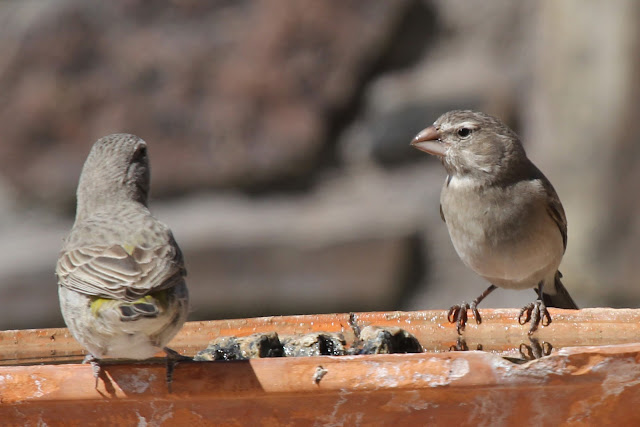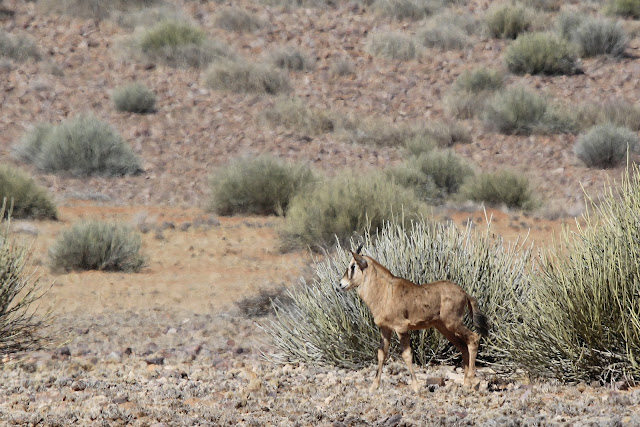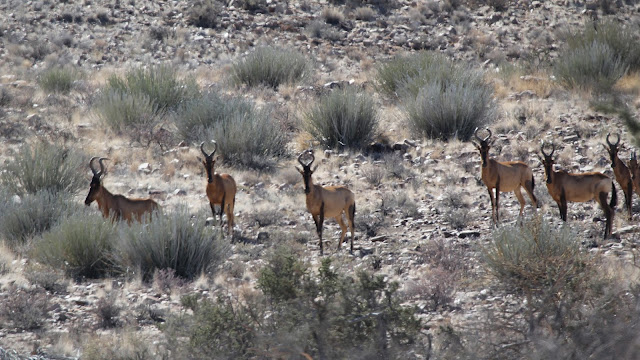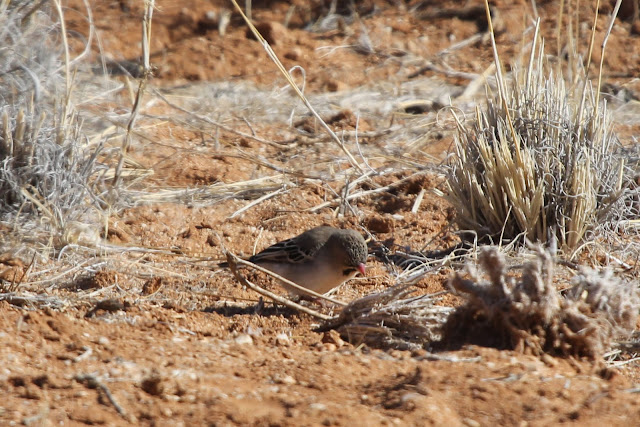The first part of our journey took us past the game reserve we had just been on, and we could see Oryx and Springbok by the fence. Flocks of Sandgrouse would fly over the road, and when a small flock flew down along side the road I stopped to get a better look.
They were Namaqua Sandgrouse, and they are very active during the early morning and late afternoon. They collect around the water holes where they drink and also wade into the water to soak up water into their feathers to take back to their young. I am not sure if they have young at the moment.
We left the gravel road and headed south on the B1, once again there was little on the road, and we could pass anything we came across quite comfortably. By now I was much more confident in the driving, and we were able to make good time. We stopped to get some fuel and provisions for the journey in Mariental. As seems to be the way here, as you approach the pumps, you are waved at madly, and directed to where they want you to go! The supermarket, was quiet, and it was strange to walk away from the car with no feeling of concern over leaving bags in it.
As we road along, we took the opportunity to catch up on some podcasts. It seemed wierd listening to Danny Baker as the African desert passed by, but it helped pass the time. We stopped again a little further on by the side for a break by the side of the road. The vast openness that surrounded us was incredible, with nothing but dust and rock to be seen for miles to the horizon.
We moved on, and at Keetmanshoop the road split with one going into South Africa, and the other, the road we were taking, heading west. We finally came off the tarmac, and followed a gravel road alongside a railway line for about 100 km with Telegraph poles disappearing into the distance.
Looking back, the clouds added to the vastness of the landscape, truly big sky country.
As we approached our new lodge the road went through another game reserve, this time without fences, the signs told us to look out for various species, but we saw nothing. As we drove on, the sun of the last few days was now watery with plenty of cloud about, and as we pulled up to the car park at Canon Lodge, and got out of the truck we were greeting with a very cold wind.
We had a small lodge that was set into the granite rocks that dominate the landscape. They have been formed in the same way that the tors on Dartmoor have been created with wind and water. The rocks extended into the rooms, and presented an interesting obstacle around the bathroom. I am sure that this helps cool the rooms in the hot summer, but it felt a very cold day.
We went for a short walk around the grounds, and found some interesting new birds very quickly. The White-backed Mousebird was found creeping through the Tamarisk outside the patio.
and on the sand a Laughing Dove huddled away from the cold wind, but started to walk away as I approached.
Scattered around on the rocks were these Rock Hyrax, or Dassies. They are apparently related to the Elephant, which with a bit of imagination you can see, but Helen likened them to over weight Meerkats!
By the side of one of the lodges was a Fiscal Shrike, for once I was able to get quite close, typically, they are distant birds perched on a wire or the top of a bush.
As we made our way up to the bar and restaurant, a black and white bird caught my eye, and I found this Acacia Pied Barbet at the top of an Acacia.
We decided to get coffee to warm us up, and ended up sitting in a sheltered spot on the terrace in the sun. We were offered a slice of cake with our coffee, which initially arrived as a coke, but when the real thing did eventually turn up it was a huge slab. Cake seems to be a tradition in Namibia, with it being served everywhere in the afternoon, and everywhere you will find it is both a huge slice, and of course the best in Namibia
The cake became an attraction for the birds. Before we had sat down I photographed this male Cape Sparrow, a very smart looking bird, about the same size as the House Sparrows.
Surprisingly they were very reluctant to come for the crumbs, but this could have been due to the size of the other birds. The Fork-tailed Drongos watched from a favourite perch.
From here they would swoop onto the terrace and pick up the crumbs, sometimes hovering just waiting to drop on them.
This is a Bokmakierie, a very impressive bird that just strode in, picked up the cake, scattering the Drongos, and then flew away
We were also joined by a pair of African Red-eyed Bulbuls that were continually chattering away to each other. They were content to wait and drop from their perches to the floor. This was a lovely pose of the pair as they sat waiting for more cake.
I mentioned that the male Cape Sparrows were reluctant to come for the crumbs, the females through were prepared to fight it out. They look as smart as the males despite the lack of the black mask.
White markings replace the black of the male, and the back and rump are a lovely russet colour.
While all this fighting was going on over the cake crumbs, a Dusky Sunbird was busy feed on the flowers of the tree alongside us. Sometimes it would dip its bill into the open petal, but the majority of the time it would use the bill to pierce at base of the petals.
This is a male, and they vary across the continent, with the western birds showing more white on the underside, and a stripe of darker feathers down the chest and belly. As it turns the sun would catch the chest feathers and they would shine green. There is also a pink patch just under the wings, but it can't be seen in this picture though.
Once we had finished the cake, the birds flew off to find someone else that couldn't cope with the huge slab. We then decided to explore the grounds. The clouds had all but gone, and the sun when sheltered was quite warm, but the wind was still very cold. We walked back to our lodge in the rocks to pick up some warmer clothes.
If you have ever seen the movie "Galaxy Quest" you may recall the scene where Tim Allen's character fights the rock man, this landscape reminded us of that scene
We walked around the grounds, found the swimming pool, which was in a beautiful location, and a lovely pool, but it was icy cold. We sat on a chair away from the wind, and enjoyed the warmth of the sun, and listened to the Pale-winged Starlings chattering away on the rocks.
We are now becoming accustomed to the concept of sundown, and today we joined some other residents to climb the rocks, and watch the sunset. As we left the cabin, the clouds were now looking very impressive in the blue sky.
As we walked up the side of the small mound of rocks, we were informed about the trees in the area, the commonest of which was the Quiver Tree, so called because the trunk was used by the San to hold their arrows, we will see plenty of these the next day.
The light was amazing, and the scene at the top of the rocks changed constantly.
The rock colour also changed as the sun sank lower in the sky.
Then it was down, and the attention turned to the colour of the sky.
It suddenly became very cold, and everyone slowly disappeared, but we stuck it out, and got our reward with a final beautiful sky.
We went down to the bar, and a table next to the fireplace, which was very welcome for the mad British People with no warm clothes.
We survived the night, it was quite cosy in the cabin, but as we ventured out to get breakfast, once again the cold wind hit us. The sun was just coming up, and everything was searching out the rays of warmth on the rocks above us.
After breakfast we set off for the canyon, apparently the light and look remains pretty much the same all day long, but we wanted to be the first there. After paying the park entrance fee, we drove down a very straight and dusty road to the main view point.
At the view point you are greeted with a huge expanse of emptiness. It is the second largest canyon in the world, and the largest in Africa. It features a gigantic ravine, in total about 160 km long, and 27 km wide, and in places 550 metres deep.
The Fish River is the longest interior river in Namibia. It cuts deep into the plateau, which today is dry , stony , and sparsely covered with hardy drought resistant plants. The river flows intermittently usually flooding in late summer; the rest of the year it becomes a chain of long narrow pools. We could see water below us, that bore this out. The canyon was originally formed by movement in the earthy, that was then carved by ice, and finally finished by the river.
With us being the only people in the car park it was very quiet, all we could hear was the sound of the cold wind. With us around the truck were Mountain Wheatear of Chats, they would perch on the small rocks in that characteristic Wheatear way.
We drove around to the furthest point, the start of the hiking trail. A st of steps wind down the side of the canyon to the bottom, and you can hike along the river, it takes between 3 to 5 days to complete. We met a pair of Germans who had just completed the hike in three days, they said it was tough, and cold at night.
Looking down you could see cactii dotted among the rocks, and the famous Quiver Trees.
The thick trunk of the tree, holds water, the tree being a member of the Aloe family, and is indigenous to this part of Africa.
We made our way back to the first view point, and then a little further along where we got out and walked a short trail to get more views.
The wild life was in short supply, but as well as the Wheatears, we came across this Familiar Chat.
and this Long-billed Lark
We picked up the two German hikers I mentioned earlier as we made our way back down the the road and out of the park. we left them at the visitor centre, and we headed off to the roadhouse for coffee and fuel. we were told last night of a self drive trail we could do around the Gondwana Canyon Park, and it started from the Roadhouse, but first we had a look around the shop and gardens, and enjoyed a coffee in a sheltered spot in the warm sunshine. We were joined by a few birds again. This Acacia Pied Barbet sang from the top of, again, an acacia tree.
While this Dusky Sunbird was extremely vocal in the large Quiver Tree that was growing alongside the terrace we were sitting on. You can see the pink in the chest feathers on this one.
There were Red-eyed Bulbuls, and Familiar Chats flying around searching for any piece of food, but new for the trip were these White-throated Canaries
Fueled up, we set off along what was going to be a 47 Km trail, the track was going to be both sand and rock, so I engaged the 4 x 4 and away we went. The Gondwana park was established in 1996 when a small group of Namibians wanted to try and preserve a small area bordering the eastern side of the Fish River canyon.
This land had been used for sheep farming for many years, but this had proved to be unsustainable in the semi desert area that receives less than 100 mm rainfall annually. What started out as an idealistic concept has grown into a ful scale park of approximately 100,000 hectares. Even in the short time it has been in place there has been a substantial recovery of both Flora and Fauna.
A lot of effort has been put into removing fences, and establishing water holes for game. Regular game counts prove that there are healthy if not small populations of Kudu. Oryx, Springbok, Ostrich, Zebra, and other smaller antelopes. The project intends to further develop the animals present, and to introduce species that were endemic, but have disappeared from the area.
We were going to help with the work, as we were given a list of animals, and we had to record the numbers we saw. so we started driving through the sand, with pen, paper, binoculars and camera at the ready.
At first the landscape was very sandy, with milk bushes everywhere. These are named after the white liquid in the stems which is very poisonous, and used by the San to tip their arrows.
In this first part there was little game to see, Helen did find a Steenbok, but it was gone before I could raise the camera. We came across a very distant Oryx though, it looked quite strange in the heat haze.
The first look out point over looked a water hole, and required a steep climb up a very rocky track. As we reached the top, we startled an Oryx, but looking down over the plain and by the waterhole we could see several more.
We spent some time at the view point, and watched the animals moving. We saw some Ostrich and two very distant Red Hartebeest, recognisable by their upright walk and distinctive horns.
We made our way down the rocky track again, and back on to the main trail, we continued to see small birds in the bush and on the ground. This one is a Clapper lark.
A Steenbook flashed across the trail, and stopped to watch us from a distance, the characteristic ears held wide as it looked at us.
I found another lark, in a bush by the side of the trail, this one is I think, Stark's Lark.
We had come across some more Oryx, but a pair in front of us were joined by a smaller brown antelope. We moved to get a better view, and in doing so we realised that it was in fact a juvenile Oryx. The horns are there, but not developed, and the coat looks very shaggy.
There were in fact two youngsters in the area, the other was lying down.
We continued on at a leisurely pace, counting as we went. We saw some distant Zebra, and they ran off over the hills and away from sight. The trail wound its way between quite high hills on both sides, and then it came out onto an open plain. We saw a group of Antelope running ahead of us, and as they came closer we could see that they were Red Hartebeest. They crossed in front of us at a distant, and then came around and stopped, so did we, and we watched the herd.
They stood and watched us as if they were deciding what to do. The hartebeest on the left in the above picture seemed to be the lead, and the others seemed to look to him for guidance, finally they moved away, slowly at first then back into a run, and gone.
Just as we were going to set off Helen picked up a raptor along the ridge, gradually it soared towards us, and I was able to get a good view of a Black-chested Snake Eagle.
We were now heading towards the next waterhole, and there was more game around us. We continued to see Oryx and Springbok, but there was also some distant Wildebeest, and Zebra. When we stopped to scan the plain, the small birds would show up. This Clapper Lark was more confiding.
And there was a small flock of Scaly Feathered Finches, although there is only one here.
At last we were able to get close to some Zebra. We thought originally these were Mountain Zebra, but a closer look shows them to be Plain's Zebra.
Time was moving on, and the sun beginning to drop, as a result there was more activity on the plains. This group of Wildebeest had just galloped across in front of us, and then settled down to watch us from a distance. As seems to be the case, an Oryx was in amongst them.
We came across many Quiver Trees on the drive, but as we approached the end of the trail the ground turned more rocky, and this seemed to suit them, and we saw them everywhere. Some looked better than others, and some were hosting sociable weaver nests. This one was almost perfect though, and looked superb in the afternoon light.
We continued to find game as we approached the lodge, a group of Zebra ran alongside us, and we also saw a few more Springbok, and then of course there are the Oryx! The final count for the drive that we handed in was as follows:
Plain's Zebra 38
Oryx 78
Springbok 42
Steenbok 4
Blue Wildebeest 46
Red Hartebeest 69
Ostrich
We could see the lodge in the distance amongst the granite hill top, originally it was a farmhouse, and the restaurant and reception are part of the old house today.
We made our way back, and picked up warmer clothes to see us through the evening. The fire once again was very welcoming, and I was continually putting logs on to keep it blazing. It had been great to be able to drive ourselves around a reserve, and not be toured, we could stop when we wanted to, and wait as long as we wanted to. I am really looking forward to the Etosha park now after today. Tomorrow we are on the road again, heading north into the Namib desert, and the dunes of Sossusvlei.





















































No comments:
Post a Comment